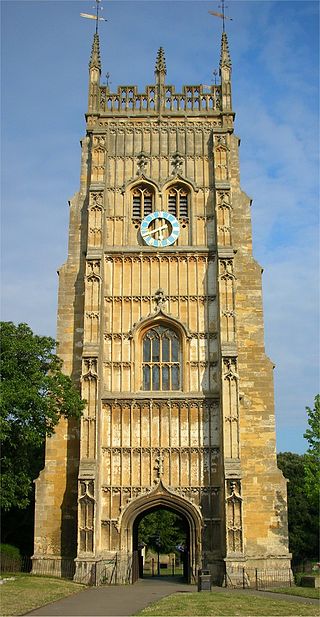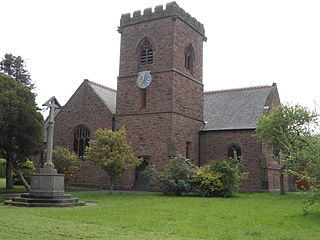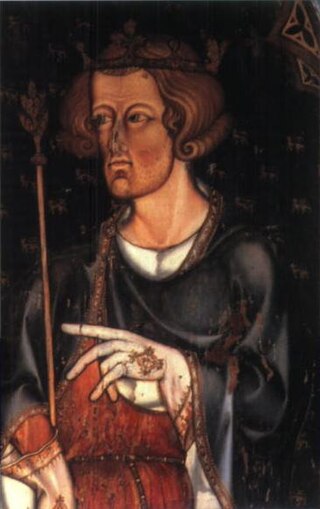Related Research Articles

Evesham Abbey was founded by Saint Egwin at Evesham in Worcestershire, England between 700 and 710 following an alleged vision of the Virgin Mary by a swineherd by the name of Eof.

Winsford is a town and civil parish in the unitary authority of Cheshire West and Chester and the ceremonial county of Cheshire, England, on the River Weaver south of Northwich and west of Middlewich. It grew around the salt mining industry after the river was canalised in the 18th century, allowing freight to be conveyed northwards to the Port of Runcorn on the River Mersey. The town of Winsford has an estimated population of 35,500 in 2024.

Over is an ancient borough, mentioned in the Domesday Book, now a part of Winsford in the Cheshire West and Chester district, in the ceremonial county of Cheshire, England. Wharton forms the eastern part, the boundary being the River Weaver. It is said to have retained its borough status and to be the smallest borough in England.

Darnhall is a civil parish and small village to the south west of Winsford in the Borough of Cheshire West and Chester and the ceremonial county of Cheshire in England. It had a population of 232 at the 2011 Census.
Vale Royal Abbey is a former medieval abbey and later country house in Whitegate, England. The precise location and boundaries of the abbey are difficult to determine in today's landscape. The original building was founded c. 1270 by the Lord Edward, later Edward I, for Cistercian monks. Edward had supposedly taken a vow during a rough sea crossing in the 1260s. Civil wars and political upheaval delayed the build until 1272, the year he inherited the throne. The original site at Darnhall was unsatisfactory, so was moved a few miles north to the Delamere Forest. Edward intended the structure to be on a grand scale—had it been completed it would have been the largest Cistercian monastery in the country—but his ambitions were frustrated by recurring financial difficulties.

Combermere Abbey is a former monastery, later a country house, near Burleydam, between Nantwich, Cheshire and Whitchurch in Shropshire, England, located within Cheshire and near the border with Shropshire. Initially Savigniac and later Cistercian, the abbey was founded in the 1130s by Hugh Malbank, Baron of Nantwich, and was also associated with Ranulf de Gernons, Earl of Chester. The abbey initially flourished, but by 1275 was sufficiently deeply in debt to be removed from the abbot's management. From that date until its dissolution in 1538, it was frequently in royal custody, and acquired a reputation for poor discipline and violent disputes with both lay people and other abbeys. It was the third largest monastic establishment in Cheshire, based on net income in 1535.

Darnhall Abbey was a late-thirteenth century Cistercian abbey at Darnhall, Cheshire, founded by Lord Edward sometime in the years around 1270. This was in thanks, so tells the Abbey's chronicler, for God saving him and his fleet from a storm at sea. It was dedicated to St Mary. It only existed for a short time before it moved to the better-known Vale Royal Abbey. The site chosen for the Abbey at Darnhall was discovered to be unfit for its purpose. Money was short, as Edward did not provide enough for the original foundation, but the Abbey was allowed to trade wool to augment its finances. The Abbey relocated a few miles north, and what remained of Darnhall Abbey became the monastic grange of the new foundation. There was probably only ever one Abbot of Darnhall before the Abbey relocated in 1275.
Roger Norreis was Abbot of Evesham in England. He was a controversial figure, installed in several offices against opposition. In his appointment to Evesham, he was accused of immoral behaviour and failing to follow monastic rules. In 1202, Norreis became embroiled in a dispute with his monks and his episcopal superior the Bishop of Worcester; litigation and argumentation lasted until his deposition in 1213. He was then appointed prior of a subsidiary monastic house of Evesham, but was deposed within months, then re-appointed to the office five years later.
Walter, Abbot of Evesham or Walter de Cerisy, Gauthier de Cerisy was an 11th-century abbot and church leader in England under the Norman conquest. He is known from the Domesday Book and several legal documents.
In the early fourteenth century, tensions between villagers from Darnhall and Over, Cheshire, and their feudal lord, the Abbot of Vale Royal Abbey, erupted into violence over whether they had villein—that is, servile—status. The villagers argued not, while the Abbey believed it was due the villagers' feudal service.
Stephen, was a late 14th-century abbot of Vale Royal Abbey in Cheshire. He is believed to have been born c. 1346, and in office from 27 January 1373 to possibly 1400, although the precise date of his departure is unknown. One of the earliest mentions of him as Abbot is 1373, when he received the homage of Robert Grosvenor for the manor of Lostock. He witnessed a charter between the prior of the Augustinian hermits in Warrington and the convent there in 1379. A few years later, Abbot Stephen provided evidence for the Royal Commission that was enquiring into the case of Scrope v Grosvenor, which sat for three years, concluding its business in 1389.
John Chaumpeneys was the last Abbot of Darnhall Abbey and first Abbot of Vale Royal Abbey, Cheshire, from around 1275 to circ 1289.
Walter of Hereford was a twelfth- and thirteenth-century Abbot of Vale Royal Abbey in Cheshire. He was Abbot from around 1294 to approximately 1307. His abbacy occurred at a time of tribulation for the abbey, mostly due to poor relations with the local populace. Walter is in portrayed in his Abbey's later chronicler in superlatives. He is described as "greatly venerable in life and always and everywhere devoted to God and the Blessed Virgin Mary" and as
A man of most beautiful appearance, as regards externals...and in good works also he fought a good fight for Christ, for he used a hair shirt to conquer the flesh, and by this discipline subdued it to the spirit. He rarely or never ate meat.
John of Hoo was an early fourteenth-century Abbot of Vale Royal Abbey, Cheshire. His abbacy was from around 1308–09 to 1314–15.
Peter was an English Cistercian abbot who served as the fifth abbot of Vale Royal Abbey, Cheshire, in the first half of the 14th century. He is generally held to be the author of the abbey's own chronicle, which was published in 1914 as the Ledger of Vale Royal Abbey. Owing to a failure to finish the abbey's building works—which had commenced in 1277 and had been intermittently ongoing ever since—the abbey was unsightly, and the monks' quarters probably near derelict. Abbot Peter oversaw the transplantation of the house onto new grounds. Much of his career, however, was focussed on defending his abbey's feudal lordship over its tenants. The dispute between the abbey and its tenantry had existed since the abbey's foundation; the abbot desired to enforce his feudal rights, the serfs to reject them, as they claimed to be by then freemen. This did not merely involve Abbot Peter defending the privileges of his house in the courts. Although there was much litigation, with Abbot Peter having to defend himself to the Justice of Chester and even the King on occasion, by 1337 his discontented villagers even followed him from Cheshire to Rutland. A confrontation between Abbot Peter and his tenants resulted in the death of a monastic servant and his own capture and imprisonment. With the King's intervention, however, Abbot Peter and his party were soon freed.
Robert de Cheyneston was Abbot of Vale Royal Abbey, Cheshire between 1340 and 1349. De Cheyneston had already been a monk at the Abbey before his election as Abbot.
Thomas Ragon was the eighth Abbot of Vale Royal Abbey, Cheshire. His term of office lasted from 1351 to 1369. His abbacy was predominantly occupied with recommencing the building works at Vale Royal—which had been in abeyance for a decade—and the assertion of his abbey's rights over a satellite church in Llanbadarn Fawr, Ceredigion, which was also claimed by the Abbot of Gloucester.
John was Abbot of Vale Royal Abbey, Cheshire, between 1405 and 1411, and although his abbacy seems to have been largely free of the local disorder that had plagued those of his predecessors, the Abbey appears to have been taken in to King Henry IV's hands on at least two occasions.
Vale Royal Abbey is a medieval abbey, and later a country house, located in Whitegate, between Northwich and Winsford in Cheshire, England. During its 278-year period of operation, it had at least 21 abbots.
References
- 1 2 3 V. C. H. 1980, pp. 156–65.
- 1 2 Brownbill 1914, p. 14.
- ↑ Sharp 2016, p. 33, 53.
- ↑ Sharp 2016, p. 33.
- ↑ Hewitt 1929, p. 166.
- ↑ Hewitt 1929, p. 155.
Bibliography
- Brownbill, J., ed. (1914). The Ledger Book of Vale Royal Abbey. Manchester: Manchester Record Society.
- Hewitt, H. J. (1929). Mediaeval Cheshire: An Economic and Social History of Cheshire in the Reigns of the Three Edwards. Manchester: Manchester University Press. pp. 111–. GGKEY:RZPQ52YFGDW.
- Sharp, B. (2016). Famine and Scarcity in Late Medieval and Early Modern England: The Regulation of Grain Marketing, 1256–1631. Cambridge: Cambridge University Press. ISBN 978-1-107-12182-9.
- V. C. H. (1980). Elrington, C. R.; Harris, B. E. (eds.). "Houses of Cistercian monks: The abbey of Vale Royal". Victoria County History. A History of the County of Chester, III. London.